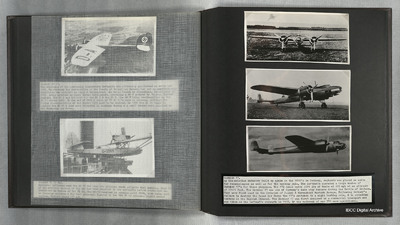Dornier 17
Title
Dornier 17
Description
Photo 1 is a front view.
Photo 2 is a starboard side view of a DO 17 on the ground.
Photo 3 is a starboard flying view of a DO 17.
Photo 2 is a starboard side view of a DO 17 on the ground.
Photo 3 is a starboard flying view of a DO 17.
Coverage
Language
Type
Format
Three b/w photographs on an album page
Publisher
Rights
This content is available under a CC BY-NC 4.0 International license (Creative Commons Attribution-NonCommercial 4.0). It has been published ‘as is’ and may contain inaccuracies or culturally inappropriate references that do not necessarily reflect the official policy or position of the University of Lincoln or the International Bomber Command Centre. For more information, visit https://creativecommons.org/licenses/by-nc/4.0/ and https://ibccdigitalarchive.lincoln.ac.uk/omeka/legal.
Identifier
PThomasAF20060032
Transcription
[Photograph]
[Photograph]
[Photograph]
Dornier 17.
As the Aviation industry built up again in the 1930’s in Germany, emphasis was placed on units for reconnaisance [sic] as well as for the bombing role. The Luftwaffe operated a large number of Dornier 17’s for these purposes. The 17Z could carry 2205 lbs of bombs at 225mph at an altitude of 13125 feet. The Dornier 17 was one of Germany’s main stay bombers during the Battle of Britain. They were first used in the invasion of Poland & throughout Western Europe. Following Germany’s failure to destroy the Royal Air Force the 17’s switched to a night bombing role, & to attacking Convoys in the English Channel. The Dornier 17 was fist designed as a commercial transport and was taken on the Luftwaffe strength in 1937. By the outbreak of war 370 were operational.
[Photograph]
[Photograph]
Dornier 17.
As the Aviation industry built up again in the 1930’s in Germany, emphasis was placed on units for reconnaisance [sic] as well as for the bombing role. The Luftwaffe operated a large number of Dornier 17’s for these purposes. The 17Z could carry 2205 lbs of bombs at 225mph at an altitude of 13125 feet. The Dornier 17 was one of Germany’s main stay bombers during the Battle of Britain. They were first used in the invasion of Poland & throughout Western Europe. Following Germany’s failure to destroy the Royal Air Force the 17’s switched to a night bombing role, & to attacking Convoys in the English Channel. The Dornier 17 was fist designed as a commercial transport and was taken on the Luftwaffe strength in 1937. By the outbreak of war 370 were operational.
Collection
Citation
“Dornier 17,” IBCC Digital Archive, accessed November 8, 2024, https://ibccdigitalarchive.lincoln.ac.uk/omeka/collections/document/23167.
Item Relations
This item has no relations.

